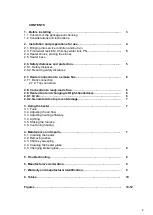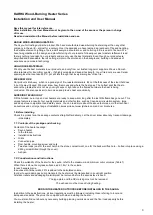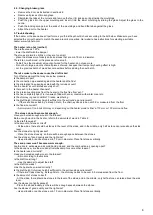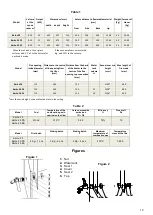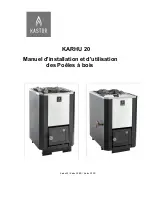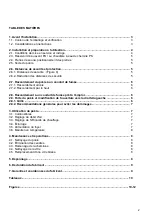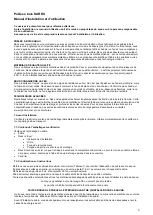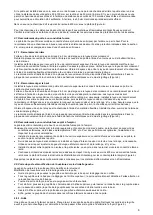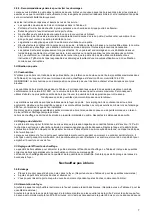
4
Before installing the chimney, you must also check the chimney's temperature class.
•
Average temperature of combustion gas on nominal output (Table 2)
•
Maximum temperature of combustion gas in safety test (Table 2)
•
Temperature classification for the chimney is T 600
Check the following issues and choose the location for the heater accordingly:
•
Safety distances to flammable and non-flammable structures (Table 1)
•
Location of the chimney connection (the height of the old chimney connection, if any, from the floor, or installation route for
a new chimney)
•
Floor material (flammable, non-flammable, tiled, waterproofed).
•
If the heater will be connected to a divided chimney (another stove has already been connected to the chimney), each
connection must have its own damper. The chimney must be sized according to the larger stove.
•
Before beginning heating, also make sure that the smoke flue draft is sufficient and that the heater is not damaged.
•
Draft in the chimney is -12Pa on nominal output.
•
Draft can be roughly checked for example by burning a bit of newsprint in the heater.
•
Before lighting, switch off equipment causing negative pressure, such as hood or machine-operated ventilation. If the
ventilation system has been equipped with a fireplace switch, use it according to the system instructions.
•
If heater has its own external delivery pipe for combustion air, make sure it is open and that there are no items causing a
blockage in front of it and that there is a supply of air. The delivery pipe can be located down by the heater on the wall or
floor. It must be equipped with a grille which can be closed or a disc valve. The minimum pipe diameter is 10 cm.
•
Karhu heaters are meant for heating a sauna. They must not be used for any other purpose.
•
The heater is not meant for continuous 24 hour use.
•
Sea water, rainwater or water containing chlorine must not be thrown onto the stones, use clean water only.
•
In the proximity of sea water, there is also the risk of corrosion for the heater; operating life may be shorter.
•
Decorative or other items must not be placed on the heater. The heater must not be covered when it is heated, or when it
is hot. E.g. drying clothes or other flammable material on the heater is forbidden due to fire risk.
•
In order to guarantee full output and safety, the fire door must always be kept shut when heating. The fire door can be
open during heating only when adding more firewood, and the heater must be continuously observed. Monitor sauna
temperature so that the heater will not overheat. If the heater becomes overheated, open the sauna door and allow
ventilation.
•
Fire doors and glass surfaces must be handled carefully.
•
Fire door handle may be hot; use a tool when opening. (glove)
•
If the heater has not been used for a long time and is located in a damp space (e.g. an unheated holiday house), it must be
carefully checked before use for corrosion damage and to make sure the chimney is not blocked, for example by a bird's
nest.
•
If a chimney fire occurs, or if there is a risk of one, close the fire doors but leave the damper on the flue open.
•
Call the fire brigade if you need help with putting the fire out.
After a chimney fire, a local chimney sweeper must always
check the condition of the flue.
•
A chimney fire, even one that was put out, must always be reported to the fire authorities.
•
Be careful! Handles, fire door glass and the surface of the heater, as well as recirculated air may be hot!
•
Do not let children light fire or stay near burning fire unless supervised by adults.
•
Follow the instructions when heating and installing the heater.
•
The heater can only be heated using unprocessed firewood.
•
Structural changes must not be made to the heater.
•
Only use original equipment and parts approved by the manufacturer.
2. Installation and preparations for use
2.1. Bringing into service condition and burn-in
•
Install the handle to the door.
•
Place the heater on a non-flammable surface outdoors, without stones.
•
Models with a water tank: attach the tap and the cap, fill the tank with water.
•
Remove all extra stickers and protective plastic (NOT the CE mark sticker).
•
Make sure that the grate is in place.
•
Install the included connecting pipe to the flue opening above the heater, the shorter section into the heater.
•
Check the caps for the soot hatches and the flue opening.
•
BURN-IN: The purpose of burn-in is to burn the protective agents off the stove outdoors, and cure the heater finish. Burn a
furnace-full of small chopped wood, re-stoke full once or twice. Continue burning the heater outdoors until the heater emits
no odour.
•
Let the heater cool down and move it indoors to the sauna.
•
Make sure there's ample ventilation during the first heatings.


